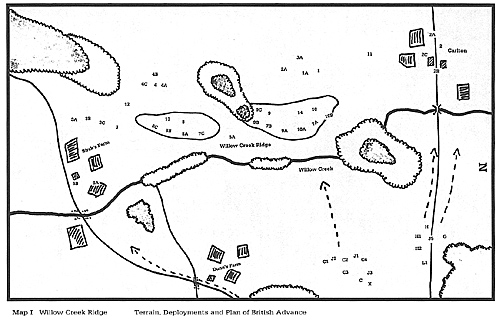In contrast to the last wargame account supplied for this publication, the following narrative is of a fictitious engagement. Further, the numbers involved were quite small: the Americans had some 6,000 men under arms, while the King's Troops had roughly 7,300 men in the field. (Please see following Orders of Battle for greater detail with respect to troop strengths, quality and organization.)
The Colonials occupied a defensive line, running North-South, along the course of Willow Creek and its like named ridge. The ridge line was the central aspect of the American defense. Both flanks were secured by builtup-areas: on the left, the hamlet of Carlton; on the right, a few scattered buildings locally known as Birck's Farm.
The ground certainly favored the defender. Not only was the ridge fortified (however lightly) with rudimentary field works, but any attacking force would have to negotiate the shallow but rapid and chilly - for this time of year - course of Willow Creek. There were just two main roads (improved wagon trails really) available for troop movement, and these were on opposite ends of the field. Both roads did cross Willow Creek; the one leading to Carlton by means of a flat, wooden bridge. (See MAP 1 below)
In brief overview, the battle plan of Lt. General Elliott was simply to hold in place and deny, by extent of casualties, the field to the English. To this end, he deployed his force in a linear fashion, with units holding both flanks and the central ridge line. If there was any rhyme or reason to his deployment, it was only that the Militia were placed in the front line. On the ridge and on the right, these inexperienced units were "protected" by field works and by the buildings and fences comprising Birck's Farm. General Elliott placed the Continental Brigades in supporting positions. The exception was on the far left flank, where a Maryland contingent occupied the small village of Carlton.
While the Continentals were held in support, as he lacked any cavalry or even an extra infantry regiment or two, the General did (could) not establish any type of reserve. Each sector of the battle line was on its own in that regard. General Elliott hoped that the British would not be able to tax, too severely, any one part of his long line.
The British plan of attack, in comparison, was more involved and complex. It comprised a threepronged attack of the American position. Timing was key to the success of the attack. Lt. General Sir Gilbert envisioned hitting the front and flanks of the Rebels simultaneously. Pressured at all points by this advance, the Americans would not be able to adequately reinforce any threatened portion of their line. And when one of the spear points of this trident did break the defenders (for British troops and their German allies were superior), it could turn left or right and roll up the rest of the Rebel line.
The right flank of this British trident was composed of the following units: Colonel Grayson's Loyalists, Blake's Legion, Swanson's Battery, the 15th Light Dragoons and the Guards Brigade. In the center, General Gilbert formed the 1st and 2nd Brigade of Regulars along with three batteries of artillery. For the left flanking force, he deployed the following units: Rosten's Rangers and the Indians / Scouts, the Hessian Brigade, a battery of artillery, and then the converged Grenadiers. (Again, please refer to MAP 1 for deployments.)

More Willow Creek Ridge
Back to MWAN #113 Table of Contents
Back to MWAN List of Issues
Back to MagWeb Magazine List
© Copyright 2001 Hal Thinglum
This article appears in MagWeb (Magazine Web) on the Internet World Wide Web.
Other military history articles and gaming articles are available at http://www.magweb.com